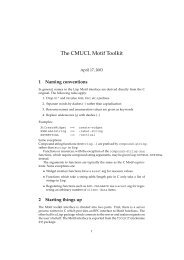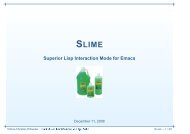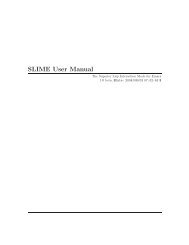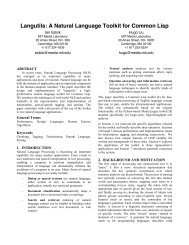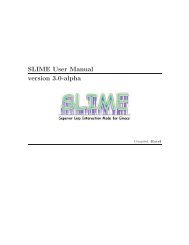Design of CMU Common Lisp.pdf - Common Lisp.net
Design of CMU Common Lisp.pdf - Common Lisp.net
Design of CMU Common Lisp.pdf - Common Lisp.net
You also want an ePaper? Increase the reach of your titles
YUMPU automatically turns print PDFs into web optimized ePapers that Google loves.
• Check that type assertions are satisfied, marking places where type checks need to be done.<br />
• Locate let calls.<br />
• Delete functions and variables with no references<br />
Files: ir1util, ir1opt<br />
ICR finalize This phase is run after all components have been compiled. It scans the global variable references,<br />
looking for references to undefined variables and incompatible function redefinitions. Files: ir1final,<br />
main.<br />
Environment analysis Determine which distinct environments need to be allocated, and what context needed<br />
to be closed over by each environment. We detect non-local exits and set closure variables. We also emit<br />
cleanup code as funny function calls. This is the last pure ICR pass. Files: envanal<br />
Global TN allocation (GTN) Iterate over all defined functions, determining calling conventions and assigning<br />
TNs to local variables. Files: gtn<br />
Local TN allocation (LTN) Use type and policy information to determine which VMR translation to use for<br />
known functions, and then create TNs for expression evaluation temporaries. We also accumulate some<br />
random information needed by VMR conversion. Files: ltn<br />
Control analysis Linearize the flow graph in a way that minimizes the number <strong>of</strong> branches. The block-level<br />
structure <strong>of</strong> the flow graph is basically frozen at this point. Files: control<br />
Stack analysis Maintain stack discipline for unknown-values continuation in the presence <strong>of</strong> local exits. Files:<br />
stack<br />
Entry analysis Collect some back-end information for each externally callable function.<br />
VMR conversion Convert ICR into VMR by translating nodes into VOPs. Emit type checks. Files: ir2tran,<br />
vmdef<br />
Copy propagation Use flow analysis to eliminate unnecessary copying <strong>of</strong> TN values. Files: copyprop<br />
Representation selection Look at all references to each TN to determine which representation has the lowest<br />
cost. Emit appropriate move and coerce VOPS for that representation.<br />
Lifetime analysis Do flow analysis to find the set <strong>of</strong> TNs whose lifetimes overlap with the lifetimes <strong>of</strong> each TN<br />
being packed. Annotate call VOPs with the TNs that need to be saved. Files: life<br />
Pack Find a legal register allocation, attempting to minimize unnecessary moves. Files: pack<br />
Code generation Call the VOP generators to emit assembly code. Files: codegen<br />
Pipeline reorganization On some machines, move memory references backward in the code so that they can<br />
overlap with computation. On machines with delayed branch instructions, locate instructions that can be<br />
moved into delay slots. Files: assem-opt<br />
Assembly Resolve branches and convert into object code and fixup information. Files: assembler<br />
Dumping Convert the compiled code into an object file or in-core function. Files: debug-dump, dump, vm/core<br />
12






